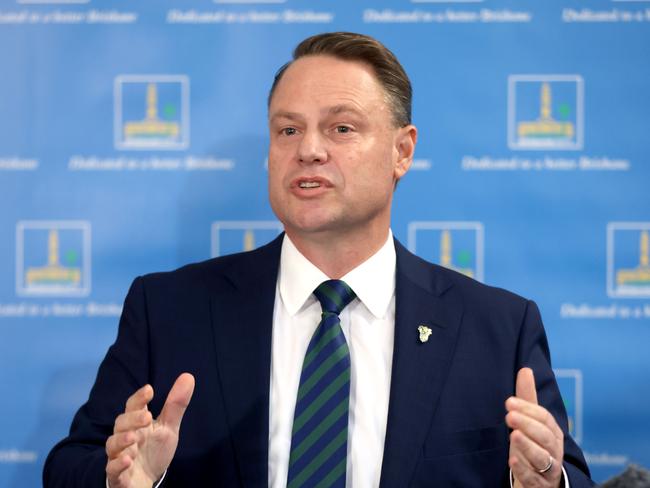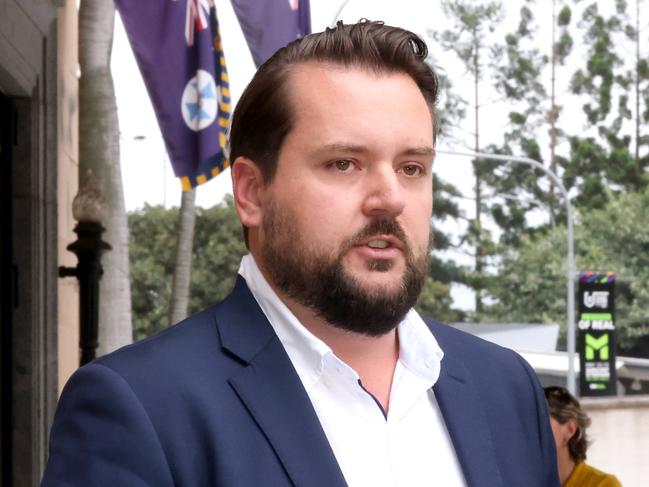Rate rise shock in Brisbane City Council budget
Brisbane City Council has revealed rates are rising across the city. Find out how much you’ll pay.
QLD Politics
Don't miss out on the headlines from QLD Politics. Followed categories will be added to My News.
Brisbane residents can celebrate the lowest rate rise in the South East after Brisbane City Council announced a record $4.3bn budget focusing on cost-of-living relief and transport infrastructure.
Residential rates have risen an average of 3.45 per cent in council budget for next financial year, costing households roughly $1.50 extra per week, compared to about $4 a week for Gold Coasters.
The 2023-24 budget, announced by Brisbane Lord Mayor Adrian Schrinner on Wednesday, is dominated by $1.43bn in infrastructure projects and includes an $80m relief package, including $22m used towards keeping Brisbane’s rates lower than any other South East council area.
Housing was another theme, with investigations under way for more affordable options such as if underused office buildings could be converted to residential apartments to boost supply.
Annual pensioner rebates have been increased to $1202 and part pensioners to $601 a year, excluding water utility.
Fees for green bin collection will be halved to $45 a year and $192m has been spent on transport subsidies – increasing by 62 per cent over the next four years.

Mr Schrinner said it was crucial to start investing in Brisbane’s transport network ahead of the 2032 Olympic and Paralympic Games.
He said many key transport upgrades were aimed at reducing congestion, while teasing a possible future underground rail network.
“Hopefully the state’s latest study decides the same,” he said.
Major road projects include the Moggil Rd corridor upgrade connecting Brisbane’s western cities, and more than $2m “congestion buster” projects for inner-city drivers.
Public transport networks have been funded a total $794.3m, including a new CityGlider bus route service between Northshore Hamilton and Woolloongabba, via Bowen Hills and the new Queen’s Wharf development.
More than $400m was allocated to the highly anticipated Brisbane Metro project, but Mr Schrinner was unable to confirm if it would become operational by late 2024, and a further $125.3m was allocated to construction of the Kangaroo Point and Breakfast Creek bridges.
Mr Schrinner also unveiled funding for a feasibility study to develop a new battery-powered ferry, to be dubbed the EVCat, and released the final master plan to convert Victoria Park golf course into an expansive parkland.
The council will pump in $141m to construct the park in Herston to be blanketed by tree canopies and ultimately play a major role during the 2032 Games as host venue of the equestrian cross-country event and BMX freestyle.
Opposition Leader Jared Cassidy said council wasted an opportunity to freeze rates for residents, and criticised the lack of suburban investment and housing affordability delivered in the budget.
“Since becoming Lord Mayor (Mr Schrinner) has jacked up rates by 17 per cent and what did the people of Brisbane have to show for it?” Mr Cassidy said.
“Instead of offering rates relief for residents who live ... in Brisbane, and providing good value for money for those rates, he’s chosen to fund the cost blowouts on his inner city projects.”
Council has reduced its net debt to $166 per capita and maintained a strong credit rating, despite Brisbane having the second-highest inflation rate in the country, with the Consumer Price Index sitting at 7.4 per cent.
There is estimated to be $3.8bn in debt for the council in 2023-24, up from $2.87bn in the current financial year.
Meanwhile, council will invest $4m in its homelessness program over the next four years to help those struggling through the housing crisis.

Mr Schrinner also announced investigations were under way to assess if underused office buildings in Carindale, Chermside, Garden City, Indooroopilly, Toombul and Toowong could be converted to residential apartments to boost housing supply.
“Are there office options that can be converted into homes for people (and) is it something that can be done cheaper than building a new building?” he said.
“I think there’s some logic there and we’re keen to work with the industry but we’re also keen to provide some incentives to get this happening sooner.”
Property Council executive director in Queensland, Jen Williams, said converting office space to residential in the city was an “excellent idea” but that previous programs had already incentivised the transformation of outdated commercial buildings.
“I’m not sure what’s left in the city that would be able to be converted and comply with fire regulations and building codes,” she said.
Workers have returned to the city following the pandemic-induced exodus, with office occupancy rates continuing to rise.
In the six months to January, Brisbane’s CBD office vacancy rate fell from 13.9 per cent to 12.9 per cent, according to the Property Council, as new businesses continued to enter the market and existing businesses increased their commercial space.


